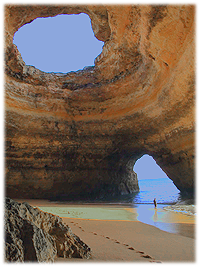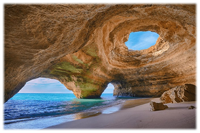.
.
.
Since the Valterrian reshaped the coast lines on both seafronts, Mathews Bay has been subject to the crashing of waves upon some of its steeply cliffs for five hundred years. This constant grinding of water against stone has eroded the coastline crafting marine grotto's both large and small. When small, these caves tend to form along weaknesses in the cliffs. As these weaknesses erode away, larger and larger chunks of soil and rock are lost, causing these sea caves to grow exponentially larger as time passes.
 These areas of weakness in the cliff give way under the force of the waves and are eroded out enlarging these cavities. The constant hydraulic pressure built up by each wave can erode further weaknesses in the stone, especially aloft, forming holes in the ceilings of these cavities leading to the outside world. These holes, commonly known as blowholes, may eventually be forced through the roof of the cave to allow the pressure created by each wave to be released as a jet of spray. The resulting spectacular cathedral like spaces are almost awe inspiring.
These areas of weakness in the cliff give way under the force of the waves and are eroded out enlarging these cavities. The constant hydraulic pressure built up by each wave can erode further weaknesses in the stone, especially aloft, forming holes in the ceilings of these cavities leading to the outside world. These holes, commonly known as blowholes, may eventually be forced through the roof of the cave to allow the pressure created by each wave to be released as a jet of spray. The resulting spectacular cathedral like spaces are almost awe inspiring.
Both the cavities and holes can get further eroded, not only by the waves, but by storms and the action of rain and weather such as ice and snow. Once opened to the surface, these sea caves can truly grow massive in size and tend to form sanctuaries of sorts for both humans and animals. These unique structures also form unique ecosystems and house plants and animals that are rarely found anywhere else. This can be true both above and below the surface of the water.
 The Sanctum Sea cave is one of these. Torn from the solid stone by year after year of wave action, seasonal storms, hundred year storms, and constant weather - this area forms a natural shelter to those who discover its existance. Located on the south side of Empyreal Beach, this sea cave is truly enormous. It has grown so large that seasonally and with the flows of tides, it will remain dry year round.
The Sanctum Sea cave is one of these. Torn from the solid stone by year after year of wave action, seasonal storms, hundred year storms, and constant weather - this area forms a natural shelter to those who discover its existance. Located on the south side of Empyreal Beach, this sea cave is truly enormous. It has grown so large that seasonally and with the flows of tides, it will remain dry year round.
This marine grotto is a natural shelter and a great place for people to enjoy the wilderness with some measure of protection. There is ample access to flotsam that makes excellent firewood and there is a fresh spring that creates a small waterfall at the back.
Both the cavities and holes can get further eroded, not only by the waves, but by storms and the action of rain and weather such as ice and snow. Once opened to the surface, these sea caves can truly grow massive in size and tend to form sanctuaries of sorts for both humans and animals. These unique structures also form unique ecosystems and house plants and animals that are rarely found anywhere else. This can be true both above and below the surface of the water.
This marine grotto is a natural shelter and a great place for people to enjoy the wilderness with some measure of protection. There is ample access to flotsam that makes excellent firewood and there is a fresh spring that creates a small waterfall at the back.









